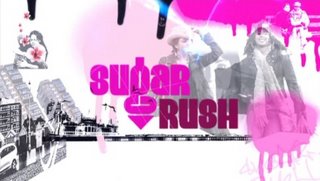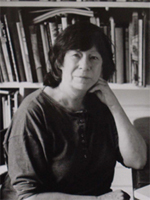‘Dear God, please stop me perving over Sugar and help me find me a fit guy to perv over instead. Or if it turns out you're OK with the whole same-sex thing, then stop Sugar messing me about and help her find her way into my bed’.
Sugar Rush is a TV show developed by Shine Limited and broadcast by Channel 4, based on the Julie Burchill novel of the same name revolving around the life of a 15 year old lesbian, Kim Daniels. Society is changing and homosexuality is being accepted by communities. In comparison to the 60’s and 70’s where homosexuality was frowned upon and seen as a horrid sin to commit as man was made for woman and not for the same sex. This no longer stands, and channel four television programme can vouch for that. Sugar rush of where each episode is a different journey inside Kim's world as her wry observations take us into the mind of a screwed up, loved up, lustful adolescent experiencing the bright lights of Brighton and the rush of forbidden love for the first time[1]. This essay will be discussing how lesbians are represented in the media with particular focus on ‘Sugar Rush’
Channel 4 is a public-service television station, where ‘Sugar Rush’ is broadcast. Channel four broadcasts all over the UK, which allows everyone who has a TV license to view the channel, Therefore on the whole channel four attracts a mainstream audience but instead Sugar Rush targets a more niche audience. By having a niche audience it allows the show to deal with real life and personal issues such as sexuality and Lesbianism. Each episode of Sugar Rush is watched on average by a million and a half households--not bad for a cult hit based on a much-criticized young adult novel[2]. Sugar Rush has not been the first show to deal with lesbianism. In the past several shows such as ‘Heartbeat’ and L.A Law’[3] in 1991 has had elements of lesbianism where two characters have had a sexual encounter small screen saw it’s first lesbian kiss. Amanda Donohoe played C.J., a bisexual lawyer on L.A. Law who kissed a female colleague on the lips. ‘Sugar Rush’ is a show based on a lesbian woman and how she deals with her day to day dilemmas of having feelings for her best friend, Sugar. The show is primarily targeting teenagers and a young adult audience due to the explicit sexual nature and strong language. Since the main character is a lesbian and the show focuses how she deals with family troubles as well as her love issues, it will also appeal to the core audience of lesbians. The fact that the show concentrates on lesbians suggests that society is more tolerant than it use to be as it was seen as unacceptable and immoral.
Sugar rush doesn’t follow the typical conventions of a standard television programme as it subverts the whole ideal of a ‘normal, nuclear family. The show portrays a mother, Stella, who refuses to take on the responsibilities of parenthood, or adulthood[4]. Kim’s brother, Matt, is confused and alienated and believes he is from a different planet. Matt is desperate for attention from his parents and others, and goes to extreme lengths to get noticed. Lastly, Kim’s father, Nathan, who is described by Kim as 'half man, half pinny'[5]. These character roles are constructed to give create a unique and realistic storyline as it is targeting a young audience that can relate to such issues. The show rejects ‘Vladimir Propp theory’ about character roles and function as the show doesn’t consist of a hero, villain or a princess. ‘Sugar Rush’ concentrates on real life characters and their situations as the show presents flashbacks to the audience in order for them to become more aware and familiar with the dilemmas occurring. The flashbacks can be seen as justifications for particular characters actions, as the producers of the show place them in suitable times during the programme for the audience to understand.
Media educators Larry Gross and George Gerbner argue that the media participate in the "symbolic annihilation"[6] of gays and lesbians by negatively stereotyping them often consigning them to the margins of entertainment media, playing either "colourful" and "flamboyant" characters or dangerous psychopaths, by rarely portraying them realistically, or by not portraying them at all. ‘Sugar Rush can vouch for these stereotypes as non existent as Kim undermines this. Kim discovers she is a lesbian in the first episode. The producers of the show do not entirely concentrate on the representation of Kim as they depict her as ‘normal’ teenage girl. Kim reveals to the audience that she is ‘sexually obsessed’[7] with Sugar. Dramatic irony is created as the audience is only aware of her feelings towards Sugar. Sugar, on the other hand is ‘straight’[8]. Kim allows the audience to become familiar with lesbianism as she is the protagonist in the show, which is ironic as men usually are in most shows, which portrays her as dominant as the entire show is from her perspective which allows the audience to identify with her.
All the women in the show are there for a different purpose as all of them suffer and long for different things. Stella, Kim's mother is longing for companionship. To help her with this, she decides to have an affair with Dale, the builder, while her husband it out making a living. This illustrates how society is changing and that woman have more of a powerful role then they use to as opposed to many years ago when women in film and TV were sexually active or seductive were likely to get killed of. This was seen as there form of punishment from society. Stella is challenging stereotypes of women and sexuality. She is stating that women are allowed to enjoy sex the way men do. She wants her sexual desires to be fulfilled as she clearly states 'Bering married to a man for 15 years and having his two children can lead to a very boring and repetitive sex life'[9]. Stella is represents a heterosexual relationship in the show in comparison to her daughter who represents the homosexual lifestyle. Women in the show are breaking traditional stereotypes and roles reversals are seen as Nathan is at home taking on the domestic role and Stella, his wife is portrayed as the homer wreaker by having an affair.
As the show primarily concentrates on the lesbian relationship between Kim and Saint as well as the feelings for Sugar within Kim, the producers have managed to include a typical conventional heterosexual quandary in order for the show to cater to all. The majority of the women in the show are seen to be independent, free and stable. They are not dependant on any male figure, besides Sugar who claims she is heterosexual, even though she had a lesbian encounter with Kim, and still conforms to the stereotype of woman needing and wanting a man. Sugar is represented as sexually active where she talks about her sexual encounters with Kim. She is depicted as very open and speaks about taboo subjects. Throughout the show, she remains jobless and lives of Sugar, who lives with her parents. Sugar seeks for male attention; she wants a man to give her guidance and support as she is alone without parental direction and only chance to survive is to provide for herself. In episode four, series two, Sugar results to stealing since she has no secure home and turns to wondering the streets of
Saint, Kim’s girlfriend, has her own business which shows she is reliable and autonomous as she does not need a man or a woman to support her. In the past, the men were seen as the breadwinners since they use to be the ones who worked, while the women were meant to remain in the house hold and only have the responsibility to look after the children and take on the domesticated roles such as cooking, cleaning and mending. Saint has her own apartment that she chooses to share with Kim. Two lesbians living together would be seen as wrong; however it is openly being accepted. Audiences would assume that they would be weaker without a man, however, they are represented as more active than passive. None of the women in the show illustrate a passive role, as all of them are rebellious and do something that would have be frown upon in society many years ago. On the whole, none of the women in the show are tied down, they have no responsibilities or children, besides Stella who refuses to take these problems on broad.
Saints and Kim’s relationship can be compared to Stella and Nathan’s relationship in the show. One relationship is homosexual, whereas the other one is heterosexual. Even though there is a major difference between the types of relationship, there behavior is presented similarly. Even though a male does not exist in Saint’s and Kim’s relationship, Saint takes on the male role and is more active than Kim. ‘Tonight was different. Tonight I was living the dream. I was buying my girlfriend a drink and nothing could stop me’[13]. Here Kim expresses her feelings and she is not ashamed of being homosexual. As mentioned previously, being homosexual was seen to be a sin. This again reinforces how the rules have changed it society. Kim feels she can have a drink down her local pub without any problems occurring from residents. Things that would usually occur within heterosexual, will still take place in the Lesbian relationship. During Episode 5 of Series 2, Kim is caught cheating on Saint with rocker
Sugar Rush is broadcast late night at
Lately in television homosexuality has become increasingly popular. On cable TV, it seems that homosexuality is no longer taboo, with gay-related programs already topping the lists of popular programs since late last year, ``The L Word'', an American TV-series featuring lesbians as the main, characters. During television’s 1997-1998 season, viewers watched as ABC’s Ellen became the first television show ever to feature an openly gay lead character, Ellen Morgan, played by actress/comedienne Ellen DeGeneres. More and more shows have been created to follow on this idea of lesbianism. Gay programs with high ratings in cable TV include Home CGV's ``Queer As Folk'' and On Style's ``Will & Grace,'' ``Queer Eye for the Straight Guy,'' and ``Playing it Straight. ''[15]. These show all feature gays and lesbians and how they break away from the typical representations of gay’s ands lesbians and portrays them with authoritative positions in their job roles. They are: An interior designer, a fashion stylist, a chef, a beauty guru and someone we like to call the “concierge of cool”[16]. The number of shows that have gay or lesbian characters in them has increased dramatically in the past five years. By doing this it challenges the hegemony as it offers an alternate representation. Prime example of this, is when ‘Rachel’ the American sitcom ‘Friends’ kisses another woman.
The representation of the characters in ‘Sugar Rush’ appeals to various different audiences in different ways. Everyone in the show is represented as being middle/working class. More recently the hegemonic representation has been replaced by what seems to be more natural representations. Key theorist Laura Mulvey argues that there is a the active male hero and the passive female characters who's mere purpose is their quality to be looked at ness and they are objectified as sexual objects and become objects of the male gaze. She declares that in a patriarchal society ‘pleasure in looking has been split between the active man and the passive female’. She also talks of the female being the object of the male gaze. This theory can be applied to 'Sugar Rush' in many ways as Sugar rush is a show that focuses on the representation of Lesbians and Women in society today. The show portrays a drastic change between the 1970's where women were usually shown to be play passive and helpless roles compared to now where they play more dominant leading roles. However, Mulvey's theory can be challenged as there is no central male role, besides Nathan and Matt, who ironically play the passive roles. Since all the main characters are female, it forces the audience to view and understand things as they see everything from their viewpoint, encouraging a female gaze. However, Mulvey’s theory can conform to Sugar Rush as parts of Sugar’s body are fetishzied in order to appeal to the male gaze. For example, in one scene the camera focuses on Sugar’s legs when she is sitting on the chair. The camera tilts starting from her legs, zoom in between her legs and finishes at her eyes. The slow, romantic diegetic sound gives the implication that Kim has sexual desires about Sugar. The attraction is shown between the characters through camera work which presents the women’s intimacy. It also depicts that a patriarchal society no longer exists and women have equal rights to men.
In the show, Sugar, Saint and Kim are represented as attractive young woman, Women that audience would aspire to look like. Generally, lesbians on the whole, are represented as good-looking women. For example, American show ‘The L word’ is a TV series about a group of lesbians living in
To conclude lesbians in the media are portrayed in a more positive way as producers of the show are not afraid that there show will not be successful if they have various representations. Having gay and lesbian characters allows the show to target a wider audience rather then one particular type. Homosexuality is still seen to be a very controversial topic as many people still believe it is a wrong thing to, however society has accepted it and the representation has developed drastically as opposed to many years ago when it was frowned upon. By having these representations it decreases homophobia and allows people to become more open about their sexuality.
[2] www.afterellen.com/TV/2006/7/sugarrush.html
[3]www.lesbianlife.about.com/cs/subject1/a/lesbiansonTV.htm
[4] http://en.wikipedia.org/wiki/Sugar_Rush_(TV_series)
[5] http://en.wikipedia.org/wiki/Sugar_Rush_(TV_series)
[7] www.channelfour.com/sugarrush
[8] www.channel4.com/life/microsites/S/sugar_rush/
[10] www.afterellen.com/TV/2006/6/sugarrush.html
[11] www.imdb.com/title/tt0452568/
[12] Yasker, Yvonne (1998): Working Girls:
[13] www.imdb.com/title/tt0452568/quotes
[14] www.afterellen.com/TV/2006/7/sugarrush.html
[15] www.times.hankooki.com/lpage/200503/kt2005032317523253460.htm
[16] www.bravotv.com/Queer_Eye/about




